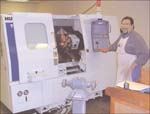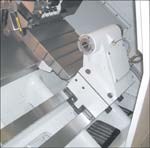Small Shop Reduces Turning Time With Lathe
For the past few years, this shop owner has taken a methodical approach to producing parts using bed mills and lathes for customers in various industries, including robotics, printing equipment, automotive and aerospace.
Centerville, Ohio is a historic community of about 24,000 located southeast of Dayton—in the center of the Midwest's machining industry. Mr. Mark Lanese, who owns Lanese Tool Company (Centerville, Ohio), has more than 25 years' experience in the metalworking industry although his shop is less than 5 years old.
For the past few years, Mr. Lanese has taken a methodical approach to producing parts using bed mills and lathes for customers in various industries, including robotics, printing equipment, automotive and aerospace.
As is often the case with a job shop, Mr. Lanese and his three full-time employees make pieces that are part of a larger assembly. Because many of its customers are relying on lean manufacturing, the company's livelihood depends on precision and quick turnover in the machining process. To stay profitable, the machines need to be running. A number of turning opportunities had presented themselves, but the poor productivity of the existing two-axis flat bed lathe with a manual four-position tool post and extended cycle times made it difficult for the shop to stay competitive. These factors led to his decision to purchase a TM-8 slant-bed CNC turning center from Hurco (Indianapolis, Indiana).
"I had worked some with Hurco mills in the past," notes Mr. Lanese. "I wasn't aware that Hurco was producing a lathe, but I had a chance to see it at a trade show. I made the purchase in early December, and the machine was installed a few weeks later. I was still concerned about how long it would take to be up and running and what kind of impact it would have on overall productivity."
Mr. Lanese was able to pick up on the conversational programming the first day and was producing parts the next day. Now he regularly runs jobs with 100- to 500-piece quantities and saves days of production time on single jobs.
The lathe is the first slant-bed type with full auto turret in the company's shop, and this level of automation has reduced cycle times and freed up Mr. Lanese to work on other jobs or generate new ones. In his third job, a 20-piece job that would have normally required programming and reprogramming, Mr. Lanese reduced cycle times. Mr. Lanese would have also had to remain at the machine throughout the process to ensure that the cuts were consistent on each piece and to change tools or repair broken pieces. With the new lathe, Mr. Lanese spent 20 minutes programming; each piece took 3 minutes to complete. There was no need to tweak the program. With the older lathes, programming might have been the same, but each piece would take 10 to 15 minutes to complete, and he would need to closely inspect each piece for variations.
Other jobs also highlight the capabilities of the lathe, including instances in which a particular part requires multiple inside diameters, two grooves and five different outside diameters using 304 stainless barstock. The total run is 250 pieces. Using the existing flat-bed lathe, the cycle time was 40 minutes for each piece because every tool change was manual. The total job time was 150 hours. Using the TM8, the job took 40 minutes to program and 8 minutes to process each part—a total of 33 hours. This saved Mr. Lanese nearly 5 days of machining time—time that can be spent working on other projects.
After performing additional jobs using the Hurco control, Mr. Lanese has reduced programming times and is benefiting from the flexibility of the control. In addition to the conversational programming, he can also program jobs using G code, off-line programming or optional CAD file import.
With faster programming and shorter processing time on the lathe, it appears that the days of long cycle times are now history.
Read Next
3 Mistakes That Cause CNC Programs to Fail
Despite enhancements to manufacturing technology, there are still issues today that can cause programs to fail. These failures can cause lost time, scrapped parts, damaged machines and even injured operators.
Read MoreThe Cut Scene: The Finer Details of Large-Format Machining
Small details and features can have an outsized impact on large parts, such as Barbco’s collapsible utility drill head.
Read More













.png;maxWidth=300;quality=90)








